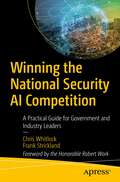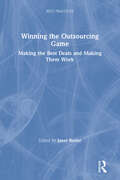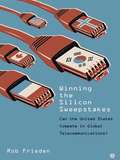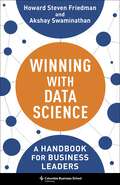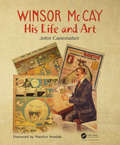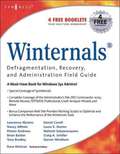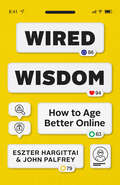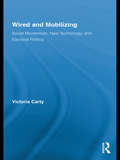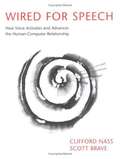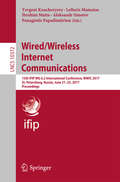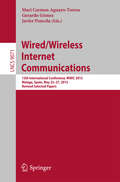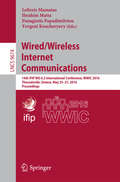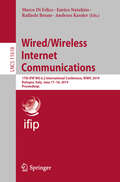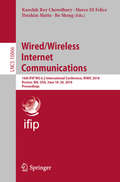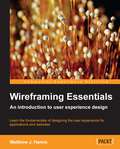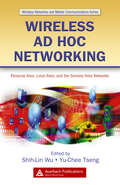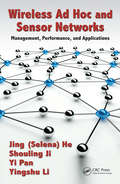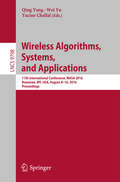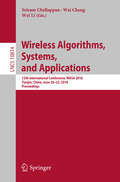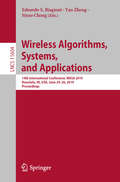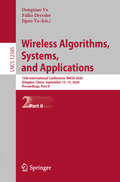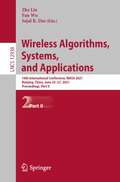- Table View
- List View
Winning the National Security AI Competition: A Practical Guide for Government and Industry Leaders
by Chris Whitlock Frank StricklandIn introducing the National Security Commission on AI’s final report, Eric Schmidt, former Google CEO, and Robert Work, former Deputy Secretary of Defense, wrote: “The human talent deficit is the government’s most conspicuous AI deficit and the single greatest inhibitor to buying, building, and fielding AI-enabled technologies for national security purposes.” Drawing upon three decades of leading hundreds of advanced analytics and AI programs and projects in government and industry, Chris Whitlock and Frank Strickland address in this book the primary variable in the talent deficit, i.e., large numbers of qualified AI leaders.The book quickly moves from a case for action to leadership principles and practices for effectively integrating AI into programs and driving results in AI projects. The chapters convey 37 axioms – enduring truths for developing and deploying AI – and over 100 leader practices set among 50 cases and examples, 40 of which focus on AI in national security. Emphasizing its impact and practical nature, LTG (ret.) Ken Tovo, former commander of U.S. Army special forces, characterized the book as “the Ranger Handbook for AI implementation!”Whether you are a senior or mid-level leader who lacks hands-on experience with AI, or an AI practitioner who lacks leadership experience, this book will equip you to lead AI programs, projects, people, and technology. As the Honorable Robert Work wrote in the foreword: “This book is not the last word on leading AI in the national security enterprise, but I believe it is an essential starting point.”You will:Review axioms or enduring truths at work in six dimensions of AI: program, budget, project, data science, people, and technologyApply best practices—such as decision frameworks, processes, checklists—for leading work in each of the six dimensions.See how the axioms and best practices are contextualized to national security missions.
Winning the Outsourcing Game: Making the Best Deals and Making Them Work (Best Practices)
by Janet ButlerIt has become increasingly difficult to hire and keep warm bodies, not to mention competent IT personnel. Winning the Outsourcing Game covers everything an IT professional needs to make the decision whether or not to outsource and to make outsourcing work once the decision is made. It includes detailed checklists for everything from drafting the RFP and contract to procedures for onsite contractors to project management and monitoring. It provides the background and the framework for IT managers to develop a sound outsourcing strategy, choose the IT functions to outsource, and effectively manage the risk of third-party contractors.
Winning the Silicon Sweepstakes: Can the United States Compete in Global Telecommunications?
by Rob FriedenIn this timely book, Rob Frieden points out the many ways the United States has fallen behind other countries in telecommunications and broadband development. Despite the appearance of robust competition and entrepreneurism in U. S. markets, there is very little of either. Because of an inattentive Congress and a misguided FCC unwilling to confront real problems, industry incumbents can earn healthy profits while keeping the United States in the backwaters of Internet-based information, communication, and entertainment markets. At every turn, regulators have tipped the scales in favor of large established companies, creating an environment that stifles innovation. As a consequence, Americans are stuck with relatively slow connectivity and with equipment that lacks features that have been staples in other countries for years. In telecommunications, the United States is a little like a third world country that is developing under crushing bureaucracies without recognizing that the rest of the world has passed it by. Professor Frieden not only shows how failure can intrude on the ability of the United States to compete but suggests how to restore its competitiveness.
Winning with Data Science: A Handbook for Business Leaders
by Howard Steven Friedman Akshay SwaminathanWhether you are a newly minted MBA or a project manager at a Fortune 500 company, data science will play a major role in your career. Knowing how to communicate effectively with data scientists in order to obtain maximum value from their expertise is essential. This book is a compelling and comprehensive guide to data science, emphasizing its real-world business applications and focusing on how to collaborate productively with data science teams.Taking an engaging narrative approach, Winning with Data Science covers the fundamental concepts without getting bogged down in complex equations or programming languages. It provides clear explanations of key terms, tools, and techniques, illustrated through practical examples. The book follows the stories of Kamala and Steve, two professionals who need to collaborate with data science teams to achieve their business goals. Howard Steven Friedman and Akshay Swaminathan walk readers through each step of managing a data science project, from understanding the different roles on a data science team to identifying the right software. They equip readers with critical questions to ask data analysts, statisticians, data scientists, and other technical experts to avoid wasting time and money. Winning with Data Science is a must-read for anyone who works with data science teams or is interested in the practical side of the subject.
Winsor McCay: His Life and Art
by John CanemakerThis volume is the only existing biography of one of America's greatest and most influential cartoonists. Winsor McCay (1867-1934) is universally acknowledged as the first master of both the comic strip and the animated cartoon. Although invented by others, both genres were developed into enduring popular art of the highest imagination through McCay's innovative genius. Included are new materials found since the previous publication of the book such as new comic strips of Little Nemo in Slumberland, and new sketches of Gertie the Dinosaur. Key Features In the book the author reviews and fully analyzes mcCay's achievements in print and film while examining his work in relation to his life, family, and to American culture and values of the period. This painstakingly thorough biography begins with mcCay's childhood in Michigan to his seat as one of the greatest of the early animators. Originally published in 1987, it is now back in print in a new expanded and revised edition. Included are new amterials found since the previous publication of the book such as new comic strips of Little Nemo inSlumberland and new sketches of Gertie the Dinosaur.
Winternals Defragmentation, Recovery, and Administration Field Guide
by Laura E. Hunter Dave KleimanThe Only Book for the Leading Winternals Tools Used in Microsoft Networks! Winternals first came to my rescue in November of 1999. It was then that I purchased my Winternals Administrator's Pak. It contained BlueSave Version 1.01, ERD Commander Professional Version 1.06, Monitoring Tools (Filemon and Regmon) Enterprise Editions Version 1.0, NTFSDOS Professional Version 3.03, NTRecover Version 1.0, and Remote Recover Version 1.01. We had a Windows NT 4 server in the dead zone. I spent a few hours reading over the ERD and Remote Recover user guides, created a "client floppy," and began my quest. Thank goodness that version of ERD had the ability to access NT-defined fault-tolerant drives. Within a few hours we had recovered the system and were back up and running. With that success, I thought back on hundreds of earlier incidents that made me wish I had purchased Winternals sooner. We have come a long way since then; the Winternals team has improved upon and added many tools and features to the Administrator's Pak utilities. One thing remains constant-in the Microsoft administrator's world, Winternals is a lifesaver.-from the Foreword by Dave Kleiman Master ERD Commander 2005 Use the ERD Commander to make a boot disk, run the Locksmith, remove hotfixes, access restore points, and more. Explore Process Activity with Process Explorer Use Autoruns and Process Explorer together to troubleshoot startups and combat malware. View the Security Settings of Your Computer Use the various Winternals tools to monitor users and shared resources, investigate suspicious local files, and search for installed rootkits. Use Sysinternals Tools to Monitor Active Sessions Use FileMon to view all file activity and Regmon to view all Registry activity. Integrate with Windows' System Programs Manage disk fragmentation, get extended file/disk information, and manage disk utilization. Perform Data Recovery Recover data across a network, recover files, and restore lost active directory data. Troubleshoot System Failures Make sense of a Windows crash, identify errant drivers, detect problematic file and registry accesses, and more. Monitor Connections with TCPTools View active network connections and identify problematic network applications using TCPView and TDIMon. Optimize NT 4.0 Systems Extend the Life of NT 4 systems using CacheSet, Contig, PMon, and Frob.
Wired Wisdom: How to Age Better Online
by Eszter Hargittai John PalfreyA surprising window into the online lives of people sixty and over—offering essential insights, no matter your age. Many popular accounts say the older you are, the greater your tech struggles. And it’s worrying to think of loved ones emailing cringe-worthy misinformation, falling for phishing attacks, or becoming lonelier with increasing time spent online. But in their eye-opening book on the internet’s fastest-growing demographic, researchers Eszter Hargittai and John Palfrey offer a more nuanced picture—debunking common myths about older adults’ internet use to offer hope and a necessary call to action. Incorporating original interviews and survey results from thousands of people sixty and over, Wired Wisdom shows that many, in fact, use technology in ways that put younger peers to shame. Over-sixties are often nimble online and quicker to abandon social media platforms that don’t meet their needs. Despite being targeted more often, they also may be less likely to fall for scams than younger peers. And fake news actually fools fewer people over sixty, who have far more experience evaluating sources and detecting propaganda. Still, there are unseen risks and missed opportunities for this group. Hargittai and Palfrey offer practical advice and show that our stereotypes can be hurdles that keep us from building intergenerational support communities, helping loved ones adopt new technology that may improve their lives, and thriving together online.
Wired and Mobilizing: Social Movements, New Technology, and Electoral Politics (Routledge Studies in Science, Technology and Society)
by Victoria CartyThis book highlights how online networking offers potential for new forms of activist mobilizing, repertoires, participatory democracy, direct action, fundraising, and civic engagement. It calls for a re-conceptualization of some of the main tenets of contentious and electoral politics, which were originally constructed to describe and analyze face-to-face forms of mobilization, in order to more accurately analyze contemporary forms of protest, electoral processes, and civil society organizing.
Wired for Innovation: How Information Technology Is Reshaping the Economy (The\mit Press Ser.)
by Erik Brynjolfsson Adam SaundersTwo experts on the information economy explore the true economic value of technology and innovation.A wave of business innovation is driving the productivity resurgence in the U.S. economy. In Wired for Innovation, Erik Brynjolfsson and Adam Saunders describe how information technology directly or indirectly created this productivity explosion, reversing decades of slow growth. They argue that the companies with the highest level of returns to their technology investment are doing more than just buying technology; they are inventing new forms of organizational capital to become digital organizations. These innovations include a cluster of organizational and business-process changes, including broader sharing of information, decentralized decision-making, linking pay and promotions to performance, pruning of non-core products and processes, and greater investments in training and education.Innovation continues through booms and busts. This book provides an essential guide for policy makers and economists who need to understand how information technology is transforming the economy and how it will create value in the coming decade.
Wired for Speech: How Voice Activates and Advances the Human-Computer Relationship
by Clifford Nass Scott BraveInterfaces that talk and listen are populating computers, cars, call centers, and even home appliances and toys, but voice interfaces invariably frustrate rather than help. In Wired for Speech, Clifford Nass and Scott Brave reveal how interactive voice technologies can readily and effectively tap into the automatic responses all speech -- whether from human or machine -- evokes. Wired for Speech demonstrates that people are "voice-activated": we respond to voice technologies as we respond to actual people and behave as we would in any social situation. By leveraging this powerful finding, voice interfaces can truly emerge as the next frontier for efficient, user-friendly technology. Wired for Speech presents new theories and experiments and applies them to critical issues concerning how people interact with technology-based voices. It considers how people respond to a female voice in e-commerce (does stereotyping matter?), how a car's voice can promote safer driving (are "happy" cars better cars?), whether synthetic voices have personality and emotion (is sounding like a person always good?), whether an automated call center should apologize when it cannot understand a spoken request ("To Err is Interface; To Blame, Complex"), and much more. Nass and Brave's deep understanding of both social science and design, drawn from ten years of research at Nass's Stanford laboratory, produces results that often challenge conventional wisdom and common design practices. These insights will help designers and marketers build better interfaces, scientists construct better theories, and everyone gain better understandings of the future of the machines that speak with us.
Wired/Wireless Internet Communications
by Yevgeni Koucheryavy Lefteris Mamatas Ibrahim Matta Panagiotis Papadimitriou Aleksandr OmetovWelcome to the 3rd International Conference on Wired/Wireless Internet C- munications (WWIC). After a successful start in Las Vegas and a selective c- ference in Germany, this year s WWIC demonstrated the event s maturity. The conference was supported by several sponsors, both international and local, and became the o?cial venue for COST Action 290. That said, WWIC has now been established as a top-quality conference to promote research on the convergence of wired and wireless networks. This year we received 117 submissions, which allowed us to organize an - citing program with excellent research results, but required more e?ort from the 54 members of the international Program Committee and the 51 additional reviewers. For each of the 117 submitted papers we asked three independent - viewers to provide their evaluation. Based on an online ballot phase and a TPC meeting organized in Colmar (France), we selected 34 high-quality papers for presentation at the conference. Thus, the acceptance rate for this year was 29%. "
Wired/Wireless Internet Communications
by Mari Carmen Aguayo-Torres Gerardo Gómez Javier PoncelaThis book constitutes the thoroughly refereed post-conference proceedings of the 13th International Conference on Wired/Wireless Internet Communications, WWIC 2015, held in Malaga, Spain, in May 2015. The 31 papers presented in this volume were carefully reviewed and selected from 43 submissions. They focus on the efficient integration of new network approaches with the traditional wired infrastructure. The topics addressed are: design and evaluation of protocols, dynamics of the integration, performance tradeoffs, and the need for new performance metrics and cross-layer interactions.
Wired/Wireless Internet Communications
by Yevgeni Koucheryavy Lefteris Mamatas Ibrahim Matta Panagiotis PapadimitriouThis book constitutes the refereed proceedings of the 14th IFIP WG 6. 2 International Conference on Wired/Wireless Internet Communications, WWIC 2016, held in Thessaloniki, Greece, in May 2016. The 27 papers presented in this volume were carefully reviewed and selected from 54 submissions. The topics addressed are: wireless technologies and systems, middleboxes and addressing, energy efficiency, network applications and tools, network protocols, network modeling, wireless sensor networks, and resource management and optimization.
Wired/Wireless Internet Communications: 17th IFIP WG 6.2 International Conference, WWIC 2019, Bologna, Italy, June 17–18, 2019, Proceedings (Lecture Notes in Computer Science #11618)
by Andreas Kassler Marco Di Felice Enrico Natalizio Raffaele BrunoThis book constitutes the proceedings of the 17th IFIP WG 6.2 International Conference on Wired/Wireless Internet Communications, WWIC 2019, held in Bologna, Italy, in June 2019.The 20 full papers presented were carefully reviewed and selected from 35 submissions. The papers address various aspects of next generation data networks, such as design and evaluation of protocols, dynamics of integration, performance tradeoffs, the need for new performance metrics, and cross-layer interactions. They are organized in the following topical sections: the Internet of Things and WLANs; security and network management; 5G and beyond 5G networks; forwarding and congestion control; and distributed applications.
Wired/Wireless Internet Communications: Second International Conference, Wwic 2004 Frankfurt (oder), Germany, February 2004, Proceedings (Lecture Notes in Computer Science #Vol. 2957)
by Ibrahim Matta Kaushik Roy Chowdhury Marco Di Felice Bo ShengThis book constitutes the proceedings of the 16th IFIP International Conference on Wired/Wireless Internet Communications, WWIC 2018, held in Boston, MA, USA, in June 2018. The 26 regular papers presented in this volume were carefully reviewed and selected from 42 submissions. They were organized in topical sections named: IoT and sensor networks; learning-based networking; network deployment; network security; aerial networks; and vehicular and content delivery networks.
Wireframing Essentials
by Matthew J. HammAn easy to follow, example-based guide introducing you to the world of user experience design through the author's real world experiences Whether you are looking to become a professional UX Designer, or just need to get the job done, the principles and processes discussed in this book will help you understand how to craft reliably effective and successful design solutions.
Wireless Ad Hoc Networking: Personal-Area, Local-Area, and the Sensory-Area Networks
by Shih-Lin Wu Yu-Chee TsengThe rapid progress of mobile, wireless communication and embedded micro-sensing MEMS technologies has brought about the rise of pervasive computing. Wireless local-area networks (WLANs) and wireless personal-area networks (WPANs) are now common tools for many people, and it is predicted that wearable sensor networks will greatly improve everyday li
Wireless Ad Hoc and Sensor Networks: Management, Performance, and Applications
by Yi Pan Yingshu Li Jing (Selina) He Mr. Shouling JiAlthough wireless sensor networks (WSNs) have been employed across a range of applications, there are few books available that cover the required algorithms, performance analysis, and applications of network management techniques in WSNs. Filling this need, this book presents new network management techniques that can address many of the shortcomings of traditional techniques. It summarizes traditional and classical network management techniques as well as state-of-the-art methods.
Wireless Algorithms, Systems, and Applications
by Qing Yang Wei Yu Yacine ChallalThis book constitutes the proceedings of the 11th International Conference on Wireless Algorithms, Systems, and Applications, WASA 2016, held in Bozeman, MT, USA, in August 2016. The 50 full papers and 9 invited papers presented werde carefully reviewed and selected from 148 submissions. WASA is designed to be a forum for theoreticians, system and application designers, protocol developers and practitioners to discuss and express their views on the current trends, challenges, and state-of-the-art solutions related to various issues in wireless networks. Topics of interests include, but not limited to, effective and efficient state-of-the-art algorithm design and analysis, reliable and secure system development and implementations, experimental study and testbed validation, and new application exploration in wireless networks.
Wireless Algorithms, Systems, and Applications: 13th International Conference, WASA 2018, Tianjin, China, June 20-22, 2018, Proceedings (Lecture Notes in Computer Science #10874)
by Wei Li Sriram Chellappan Wei ChengThis book constitutes the proceedings of the 13th International Conference on Wireless Algorithms, Systems, and Applications, WASA 2018, held in Tianjin, China, in June 2018.The 59 full papers and 18 short papers presented in this book were carefully reviewed and selected from 197 submissions. The papers cover various topics such as cognitive radio networks; wireless sensor networks; cyber-physical systems; distributed and localized algorithm design and analysis; information and coding theory for wireless networks; localization; mobile cloud computing; topology control and coverage; security and privacy; underwater and underground networks; vehicular networks; internet of things; information processing and data management; programmable service interfaces; energy-efficient algorithms; system and protocol design; operating system and middle-ware support; and experimental test-beds, models and case studies.
Wireless Algorithms, Systems, and Applications: 14th International Conference, WASA 2019, Honolulu, HI, USA, June 24–26, 2019, Proceedings (Lecture Notes in Computer Science #11604)
by Edoardo S. Biagioni Yao Zheng Siyao ChengThis book constitutes the proceedings of the 14th International Conference on Wireless Algorithms, Systems, and Applications, WASA 2019, held in Honolulu, HI, USA, in June 2019. The 43 full and 11 short papers presented were carefully reviewed and selected from 143 submissions. The papers deal with new ideas and recent advances in computer systems, wireless networks, distributed applications, and advanced algorithms that are pushing forward the new technologies for better information sharing, computer communication, and universal connected devices in various environments, especially in wireless networks.
Wireless Algorithms, Systems, and Applications: 15th International Conference, WASA 2020, Qingdao, China, September 13–15, 2020, Proceedings, Part I (Lecture Notes in Computer Science #12384)
by Falko Dressler Jiguo Yu Dongxiao YuThe two-volume set LNCS 12385 + 12386 constitutes the proceedings of the 15th International Conference on Wireless Algorithms, Systems, and Applications, WASA 2020, which was held during September 13-15, 2020. The conference was planned to take place in Qingdao, China; due to the COVID-19 pandemic it was held virtually. The 67 full and 14 short papers presented in these proceedings were carefully reviewed and selected from 216 submissions. These submissions cover many hot research topics, including machine-learning algorithms for wireless systems and applications, Internet of Things (IoTs) and related wireless solutions, wireless networking for cyber-physical systems (CPSs), security and privacy solutions for wireless applications, blockchain solutions for mobile applications, mobile edge computing, wireless sensor networks, distributed and localized algorithm design and analysis, wireless crowdsourcing, mobile cloud computing, vehicular networks, wireless solutions for smart cities, wireless algorithms for smart grids, mobile social networks, mobile system security, storage systems for mobile applications, etc.
Wireless Algorithms, Systems, and Applications: 15th International Conference, WASA 2020, Qingdao, China, September 13–15, 2020, Proceedings, Part II (Lecture Notes in Computer Science #12385)
by Falko Dressler Jiguo Yu Dongxiao YuThe two-volume set LNCS 12385 + 12386 constitutes the proceedings of the 15th International Conference on Wireless Algorithms, Systems, and Applications, WASA 2020, which was held during September 13-15, 2020. The conference was planned to take place in Qingdao, China; due to the COVID-19 pandemic it was held virtually. The 67 full and 14 short papers presented in these proceedings were carefully reviewed and selected from 216 submissions. The papers focus on data path algorithms; control path algorithms; network protocol design; network security; network services; and cloud computing.
Wireless Algorithms, Systems, and Applications: 16th International Conference, WASA 2021, Nanjing, China, June 25–27, 2021, Proceedings, Part I (Lecture Notes in Computer Science #12937)
by Fan Wu Sajal K. Das Zhe LiuThe three-volume set LNCS 12937 - 12939 constitutes the proceedings of the 16th International Conference on Wireless Algorithms, Systems, and Applications, WASA 2021, which was held during June 25-27, 2021. The conference took place in Nanjing, China.The 103 full and 57 short papers presented in these proceedings were carefully reviewed and selected from 315 submissions. The following topics are covered in Part I of the set: network protocols, signal processing, wireless telecommunication systems, blockchain, IoT and edge computing, artificial intelligence, computer security, distributed computer systems, machine learning, and others.
Wireless Algorithms, Systems, and Applications: 16th International Conference, WASA 2021, Nanjing, China, June 25–27, 2021, Proceedings, Part II (Lecture Notes in Computer Science #12938)
by Fan Wu Sajal K. Das Zhe LiuThe three-volume set constitutes the proceedings of the 16th International Conference on Wireless Algorithms, Systems, and Applications, WASA 2021, which was held during June 25-27, 2021. The conference took place in Nanjing, China.The 103 full and 57 short papers presented in these proceedings were carefully reviewed and selected from 315 submissions. The contributions in Part II of the set are subdivided into the following topical sections: Scheduling & Optimization II; Security; Data Center Networks and Cloud Computing; Privacy-Aware Computing; Internet of Vehicles; Visual Computing for IoT; Mobile Ad-Hoc Networks.
